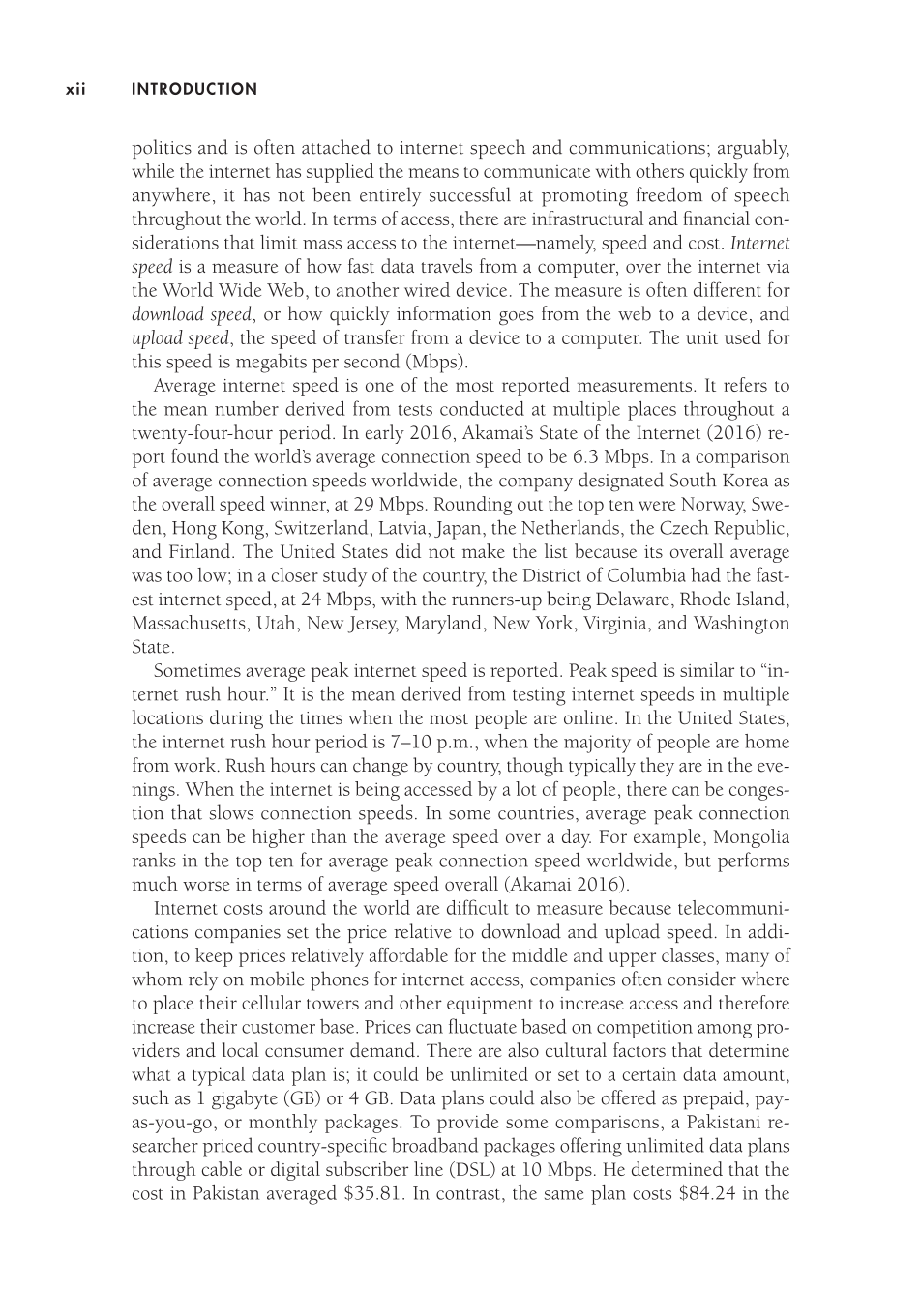Introduction xii
politics and is often attached to internet speech and communications; arguably,
while the internet has supplied the means to communicate with others quickly from
anywhere, it has not been entirely successful at promoting freedom of speech
throughout the world. In terms of access, there are infrastructural and financial con-
siderations that limit mass access to the internet—namely, speed and cost. Internet
speed is a measure of how fast data travels from a computer, over the internet via
the World Wide Web, to another wired device. The measure is often different for
download speed, or how quickly information goes from the web to a device, and
upload speed, the speed of transfer from a device to a computer. The unit used for
this speed is megabits per second (Mbps).
Average internet speed is one of the most reported measurements. It refers to
the mean number derived from tests conducted at multiple places throughout a
twenty-four-hour period. In early 2016, Akamai’s State of the Internet (2016) re-
port found the world’s average connection speed to be 6.3 Mbps. In a comparison
of average connection speeds worldwide, the company designated South Korea as
the overall speed winner, at 29 Mbps. Rounding out the top ten were Norway, Swe-
den, Hong Kong, Switzerland, Latvia, Japan, the Netherlands, the Czech Republic,
and Finland. The United States did not make the list because its overall average
was too low; in a closer study of the country, the District of Columbia had the fast-
est internet speed, at 24 Mbps, with the runners-up being Delaware, Rhode Island,
Massachusetts, Utah, New Jersey, Maryland, New York, Virginia, and Washington
State.
Sometimes average peak internet speed is reported. Peak speed is similar to “in-
ternet rush hour.” It is the mean derived from testing internet speeds in multiple
locations during the times when the most people are online. In the United States,
the internet rush hour period is 7–10 p.m., when the majority of people are home
from work. Rush hours can change by country, though typically they are in the eve
nings. When the internet is being accessed by a lot of people, there can be conges-
tion that slows connection speeds. In some countries, average peak connection
speeds can be higher than the average speed over a day. For example, Mongolia
ranks in the top ten for average peak connection speed worldwide, but performs
much worse in terms of average speed overall (Akamai 2016).
Internet costs around the world are difficult to measure because telecommuni-
cations companies set the price relative to download and upload speed. In addi-
tion, to keep prices relatively affordable for the middle and upper classes, many of
whom rely on mobile phones for internet access, companies often consider where
to place their cellular towers and other equipment to increase access and therefore
increase their customer base. Prices can fluctuate based on competition among pro-
viders and local consumer demand. There are also cultural factors that determine
what a typical data plan is; it could be unlimited or set to a certain data amount,
such as 1 gigabyte (GB) or 4 GB. Data plans could also be offered as prepaid, pay-
as-you-go, or monthly packages. To provide some comparisons, a Pakistani re-
searcher priced country-specific broadband packages offering unlimited data plans
through cable or digital subscriber line (DSL) at 10 Mbps. He determined that the
cost in Pakistan averaged $35.81. In contrast, the same plan costs $84.24 in the





























































































































































































































































































































































































































































